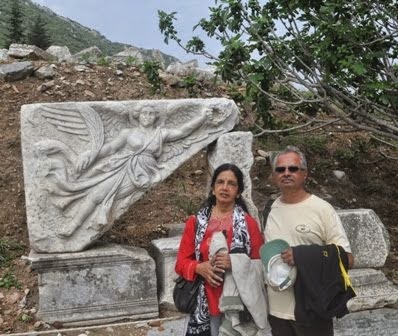After our visit to Denmark, we took an overnight cruise from Copenhagen to Oslo in Norway. (JUNE 2010)
From Oslo we had a bus journey to Bergen on the West coast of Norway through beautiful country side full of green hills and waterfalls. At Bergen a funicular train takes us to the top of a hill from where we get a panoramic view of the city.
From Bergen we took a bus to Gudvangen and from there by cruiser to Flam. The cruise is in the FJORDS of Norway. Fjords are back waters. Unlike the back waters in Kerala these are very wide. There are a quite a large number of small and big islands. There are small jetties for boats and beautiful buildings in these islands. During the cruise sea gulls come to feed on bread crumbs and fruits from passengers hands.
Flam is known for its mountain railway, Flambano, one of the steepest in the world and for its numerous tunnels, probably the only one with a 180 degree curve inside a tunnel. The gradient is 55/1000, almost 1 in 18 along 80% of the length. The railway is 20 kms long and has 6 tunnels. The journey takes about an hour. It is a great engineering marvel.It raises from Flam valley to Myrdal 1320 M high. The train has a photo stop on the way at Kjosfossen, a magnificient waterfall. Probably this is the only place in the world where a train stops and waits while passengers get down to take photographs. After an hour’s thrilling train journey we reach Myrdal from where we took another train to Geilo.
Geilo is a sleepy little village where we took a halt after all the excitement before boarding the bus next day for Karlstad in Sweden. The bus journey from Geilo to Karlstad is absolutely scary as the bus climbs down the Myrdalsberget mountain on which there are 21 hair pin bends continuously. It is really wonderful to see the control exercised by the driver when he manoeuvres the bus on these bends. A river is seen down below like a silver ribbon.
I have attached a separate write up about Flam railway and photos of this journey. Hope you enjoy reading and looking at them.
FLÅM RAILWAY – NORWAY
ONE OF THE MOST BEAUTIFUL RAILWAY LINES IN THE WORLD
It is an incredible 20 kilometer long train journey from the mountain station at Myrdal on the Bergen Railway, down to Flåm station nestled in the innermost corner of the Aurlandfjord.
The Flåm Railway, which passes through the beautiful, narrow Flåm valley, is regarded as a masterpiece of Norwegian engineering. The Flåm Railway is one of the world’s steepest railway lines on normal gauge. The gradient is 55/1000 on almost 80% of the line, i.e. a gradient of one in eighteen. Part of the track is so steep that the train will use 5 different braking systems. The twisting tunnels that spiral in and out of the mountain are manifestations of the most daring and skilful engineering in Norwegian railway history. Work was begun on the Flåm Railway in 1923. It took 20 years to complete. The Flåm Railway was opened temporarily for steam engines on 1 August 1940
The train leaves the green fields and orchards of the valley floor before continuing alongside the river and through tunnels. As the train exits Nåli, the Flåm Railway's longest tunnel (1320 metres), you will catch a glimpse of the most spectacular and interesting view on the railway's ascent to Myrdal - the railway track on four different levels in the mountain side and a part of Myrdal station. At the same time, you will see the old road winding its way via 21 hairpin bends up the steep Myrdalsberget mountain. The steep mountainsides were a major challenge, the solution being to build hairpin tunnels in order to equalise the big differences in altitude on the steep mountain. The train passes through a hairpin tunnel that turns 180°, an opening in the tunnel affording a panoramic view of the wild landscape. Several hundred metres straight down from the carriage window the river resembles a silver ribbon lying on the valley floor, while you see the steep mountainside with the rail track cut into a narrow ledge.
The Flåm Railway crosses the valley and river three times, but there are no bridges over the river. Instead of bridges, the river is led through the mountain in tunnels underneath the railway line.
The most time-consuming work was on the tunnels. These were excavated manually. Only two of the twenty tunnels, which have a total length of 6 km, were excavated using machines. Every metre of tunnel cost the labour force, the navvies, up to a month's hard work. The labour force, 120 strong at the outset, rapidly increased to 220 at the peak.
The train has a photo stop at Kjosfossen. There is no other place on earth where rail travellers can get down from the train and have the chance to see such an impressive waterfall as from the platform at Kjosfossen, while the train waits for them. High up on the horizon you see the white water cascading off the steep mountain side. The rushing river of water dissolves into foam with a thunderous roar as it hits the mountain on its way down. According to a Norwegian legend, a temptress lives behind these falls and tries to lure men to the rocks by her singing. The train passes Reinungvatnet, a truly beautiful mountain lake before you get your last magnificent view of the mountains and moorland at Vatnahalsen. An unforgettable train journey comes to an end at Myrdal.
